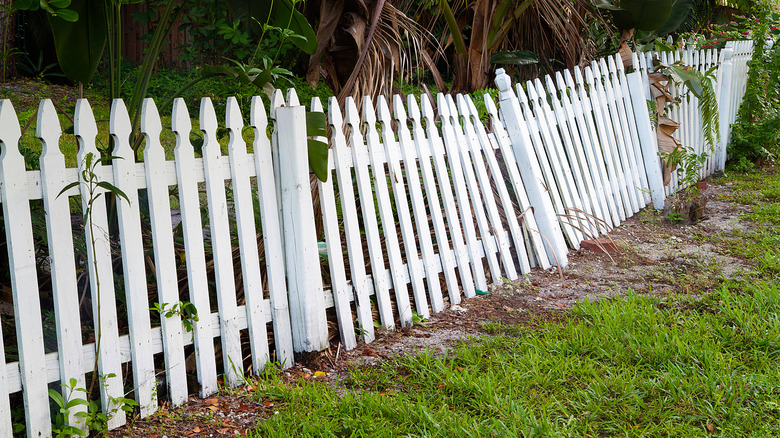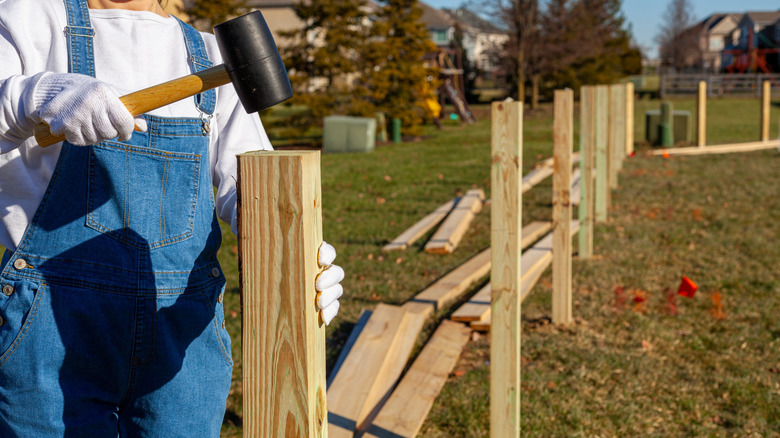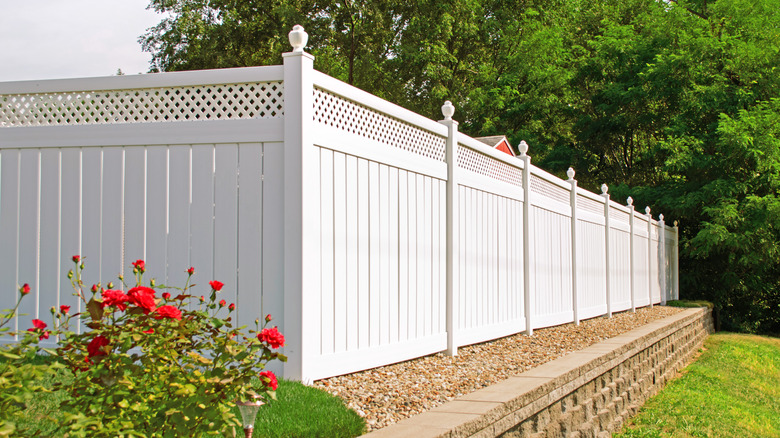Leaning Fence? We've Found The Culprit And Show You How To Fix It
We may receive a commission on purchases made from links.
Good fences make good neighbors. Bad fences, on the other hand, create nothing but problems. Building the perfect fence isn't easy, but when you select the right materials, allocate adequate time for installation, and perform maintenance as needed, a fence may increase your property value. When you have an old fence that is starting to warp or tilt, however, it can severely impact your home's curb appeal and create privacy and safety concerns. If you're anxious to fix a leaning fence, we can help. In an exclusive interview with House Digest, our expert carpenter and remodeler Bob Beacham said that the culprit is usually your fence posts.
"It's almost always going to be a problem with the posts," Beacham explained. "Wood rotting at the base is common." Even when set into concrete, if your posts aren't made from weather-treated wood, set at a proper depth, or the ground has shifted due to freeze and thaw cycles, you can quickly run into problems. Beacham said that metal posts can also start to lean when weather exposure over time causes them to rust.
There's also another possible cause. "If the posts were installed too far apart, the panels or mesh in between can stretch and sag," Beacham told us. Although they're usually the issue, problematic posts aren't the only things that can start to show signs of weathering. You'll also want to look closely to see if the fence material itself is damaged or decayed.
Replace faulty posts instead of relying on quick fixes
Failing to consider your soil type, wind exposure, and site drainage are common mistakes everyone makes when installing a fence. If your fence starts to lean, you'll want to address these and other potential pitfalls before you start to DIY a fix. In his exclusive interview with House Digest, Bob Beacham told us that the first step is extremely simple. "Replace the faulty post(s). If it's concrete that's shifted and the post is sound, dig around the lump, straighten it, and reinforce it with more concrete." Beacham suggested using an angled post to support the fix while the new concrete sets. When the horizontal supports are broken, he said that you should replace them instead of attempting to splint them to avoid having to make repairs more than once. "A quick fix [will] fail eventually," he cautions.
When your fence panels are made from wire mesh or another lightweight material, and wind force isn't a serious concern, Beacham suggested another approach. "The wires can probably be tightened or restrung," he said. A tool like the Seiria Fence Wire Twister — one made of stainless steel strong enough to twist any thickness of fencing material — can make the process much easier than standard pliers. However, if you're worried about hand fatigue or want a tool that is also capable of cutting old wire fencing and pulling out rusty staples, a tool like the IRWIN VISE-GRIP Fencing Pliers may be a better choice.
Prevent fence problems with proactive maintenance
Whether you're installing a new fence or repairing an old one, you'll quickly find that fence materials are expensive. In his exclusive interview with House Digest, Bob Beacham told us how to make sure your investment is worth it. "Do regular inspection and maintenance," he advised. "Walk the perimeter every couple of months and check for damage, or signs of rot or rust." Beacham said that you should check more often if you live in an area with extreme weather. "Treat wood or repaint metal every few years," he added. Applying popular coatings like Storm System Protector Outdoor Wood Stain and Sealer can extend the life of wood posts and fencing, while products like Rust-Oleum Stops Rust Hammered Finish Paint works well for metal fences.
Sometimes, a badly damaged or neglected fence will be beyond repair. "It has to be a judgment call depending on the general condition of the fence," Beacham said. He recommends doing an honest assessment of your situation before embarking on a DIY solution, and suggests asking questions such as "How much time and material will be required to complete the repair? What's the condition of the rest of the fence? Will further repairs be needed in 6 or 12 months?" Depending on the answers, Beacham said that your money may be better invested in replacing instead of repairing your fence.


